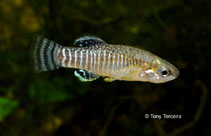| Family: |
Aphaniidae (Oriental killifishes) |
| Max. size: |
5.5 cm TL (male/unsexed); 5.4 cm TL (female) |
| Environment: |
benthopelagic; freshwater; brackish; pH range: 6.5 - 7.5; dH range: 8 - 10, non-migratory |
| Distribution: |
Europe: Spain along Mediterranean coast from 30 known localities (now extirpated in 14 of them). Historical records from near Perpignan, France now extirpated. Populations from Algeria and the Atlas along Morocco-Algeria border have long been identified as Aphanius iberus but they belong to Aphanius saourensis and other, unnamed and possibly extinct, species (Ref. 59043). |
| Diagnosis: |
Dorsal spines (total): 0-0; Dorsal soft rays (total): 9-11; Anal spines: 0-0; Anal soft rays: 7-10. Can be diagnosed from other species of Aphanius, Valenciidae and Fundulidae in Europe by having the following characters: males possess a hyaline to bluish-grey caudal fin, with 2-5 dark grey bars, 10-20 dark grey to dark blue bars on a silvery background, bars usually irregularly shaped and set, often connected, breaking up into a mosaic of dark blue and silvery spots along back and in posterior part of body; females have numerous dark brown spots on sides and back; 23-27 scales in lateral line series on body; pectoral fin with 9-10 rays; and anal fin with 7-8 rays (Ref. 59043). |
| Biology: |
Inhabits lagoons, salt marshes, swamps, estuaries and freshwaters. Euryhaline, occurring in water bodies with salinities ranging from freshwater to 57 ppt (Ref. 59043). Occurs in lowland water with little current. Spawns from April to September. Is an egg-laying carnivorous fish which is used for mosquito control (Ref. 26100). This short-lived species is now threatened throughout its entire range because of habitat destruction and because of the introduction of Gambusia affinis (Ref. 3788). Not a seasonal killifish. Is easy to maintain in the aquarium (Ref. 27139). |
| IUCN Red List Status: |
Endangered (EN); Date assessed: 31 January 2006 (A2ce) Ref. (130435)
|
| Threat to humans: |
harmless |
Source and more info: www.fishbase.org. For personal, classroom, and other internal use only. Not for publication.

